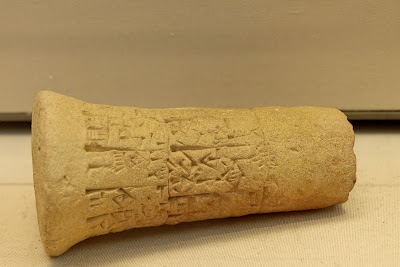A Note on Foundation Nails in Ancient Near Eastern Temples
I recently had a paper published through Interpreter that argues that Isaiah 22:20–25 and its reference to a “nail in a sure place” should be understood as a temple text.[1] One aspect of this that I began exploring after the paper had been accepted involves how ancient Near Eastern temples would use what scholars have called a foundation nail. While I could not expand upon that thought in my paper due to the timing, I wanted to share this “addendum” of sorts in hopes that this can be further explored (whether by myself or others) in the future.
One possibility regarding the nail mentioned in Isaiah 22 and Ezra 9 could place it in terms of the dedication or foundation nails employed in other Near Eastern cultures in which a king placed a clay nail in the foundation of a temple with an inscription dedicating it to the temple’s god.[2] One famous example, the clay nail of King Enmetena of Lagash, includes on the inscription a note about a covenant of peace that he had made with the king of Uruk.[3] The nail as referenced in Isaiah and Ezra, however, is different—it is the heavenly king who bestows the nail on those with whom He gives His authority, rather than the people dedicating the nail to the heavenly king.[4] While I am not aware of any similar practice found among Israelite temples, Isaiah may have been drawing on a wider cultural image for his audience.
[1] Spencer Kraus, “‘A Mystery to the World’: A New Proposal for Isaiah 22:20–25,” Interpreter: A Journal of Latter-day Saint Faith and Scholarship 58 (2023): 37–50.
[2] For a brief introduction to the use of these nails in Near Eastern temples, see Edward Chiera, They Wrote on Clay: The Babylonian Tablets Speak Today (Chicago, IL: Chicago University Press, 1938), 93; Renate Marian van Dijk-Coombes, “A Neo-Sumerian Clay Nail of Gudea in the Collection of the Department of Ancient Studies of Stellenbosch University,” Antiguo Oriente 14 (2016): 56–57.
[3] For a translation and brief note about this nail, see Deena Ragavan, “Cuneiform Texts and Fragments in the Harvard Art Museum / Arthur M. Sackler Museum,” Cuneiform Digital Library Journal 2010:1, 1–3.
[4] Another example where the Lord, as the heavenly king, apparently condescends to His children in a covenant making context is found in Genesis 15, in which the Lord passes between the cut carcasses of animals to ratify His covenant with Abraham.


.jpg)
Comments
Post a Comment
Thoughtful comments are welcome. All comments are moderated.